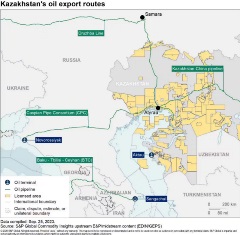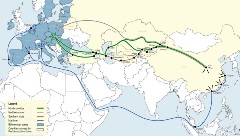The
Kazakhstan economy relies heavily on its oil and gas industry, with most of its exports transported over pipelines that run through Russia to Europe. While dependent on Europe’s oil market, Kazakhstan also has close historical and security ties with neighbouring Russia, putting them in a difficult position when the war in Ukraine broke out.
In 2022, the oil and gas industry accounted for about 20% of Kazakhstan’s GDP and constituted 61% of Kazakhstan’s total exports (Table 1). About 77% of Kazakhstan’s crude oil and crude oil products in 2022 were exported, mainly to markets in Europe and East Asia (Table 2). Out of 64 million tonnes of oil exported by Kazakhstan in 2022, 52 million tonnes (81%) were transported through the Caspian Pipeline Consortium (CPC) Pipeline, 8 million tonnes (13%) through Atyrau-Samara-Druzhba Pipelines, 2 million tonnes (4%) through Aktau port, 1 million tonnes (2%) through the Kazakhstan-China Pipeline (KCP), and 0.4 million tonnes (0.6%) by rail transport (Figure 1). The CPC and Atyrau-Samara-Druzhba Pipelines, which run through Russia, account for 94% of Kazakhstan’s oil exports.
Russia’s war with Ukraine and the consequent European Union sanctions against Russia have jeopardised the reliability of Russian pipelines. Kazakhstan’s oil exports to Europe via Russia experienced intermittent disruptions in 2022 and 2023. This has pushed the Kazakhstan government to seek alternative oil export routes.
Table 1: Oil and Gas Sector Contribution to Kazakhstan’s GDP (Gross Value Added), 2022| Sector | Gross Value Added (Millions, Tenge*) | Share in GDP (%) |
| Oil and gas | 20,172,444 | 20 |
| Non-oil and gas | 76,195,072 | 73 |
| Raw sources# | 20,655,615 | 20 |
| Non-raw sources# | 75,711,901 | 73 |
*As of April 5, 2024, US$1 = 446.46 Kazakhstan Tenge (KZT). www.xe.com
# Raw sources include crop and animal production, hunting and related service activities; forestry and logging; fisheries and aquaculture; and the mining industry (including extraction of crude oil and natural gas).
Table 2: Kazakhstan’s Main Fuel Export Markets, 2022
| Country | Exports (US$ Thousands) | % of Total Fuel Exports | Export Product Share (%) |
| World | 51,788,936 | 100 | 68 |
| Italy | 13,331,701 | 26 | 98 |
| China | 5,367,119 | 10 | 51 |
| Netherlands | 5,204,853 | 10 | 98 |
| South Korea | 4,415,771 | 9 | 98 |
| Türkiye | 3,446,702 | 7 | 94 |
| France | 2,723,751 | 5 | 91 |
| Romania | 2,432,694 | 5 | 100 |
| Spain | 2,196,376 | 4 | 96 |
| Singapore | 1,872,132 | 4 | 100 |
| India | 1,707,411 | 3 | 91 |
 Source: S&P Global Commodity Insights, “Kazakhstan’s Oil Supply Reshaping: Is There a Viable Alternative to the CPC Pipeline,” October 9, 2023.
Source: S&P Global Commodity Insights, “Kazakhstan’s Oil Supply Reshaping: Is There a Viable Alternative to the CPC Pipeline,” October 9, 2023.
Alternative Oil Export Arrangements
To diversify from Russia, there are four main alternative routes for Kazakhstan’s oil exports, with each presenting specific challenges:
- Middle Corridor (MC);
- Northern Corridor (NC);
- Kazakhstan-China Pipeline (KCP); and
- Southern Alternative
Alternative 1: The Middle Corridor (MC)
The entire MC consists of 4,250km of land route and 500km of seaway from China to Europe (Figure 2). When fully developed, the MC could potentially move goods in less time than the NC and maritime route (MR). The development of the MC is supported by the Central Asian countries, China, Europe, the US and multilateral development banks.
Kazakhstan President Kassym-Jomart Tokayev believed that the MC was the most promising alternative, because it ran westward to Europe while bypassing Russian territory. The oil is first transported from Kazakhstan’s oil fields to its Aktau or Kuryk ports via railroad, then shipped over the Caspian Sea to Azerbaijan’s capital and port at Baku, where it is transported via the Baku-Tbilisi-Ceyhan pipeline to Ceyhan port in Türkiye, the Baku-Supsa pipeline to Georgia or via rail to the Georgian ports of Batumi, Poti or Kulevi before continuing to Europe.
Figure 2: Main Asia-Europe Trade and Transport Routes
 Source: The World Bank, Middle Trade and Transport Corridor: Policies and Investments to Triple Freight Volumes and Halve Travel Time by 2030, November 2023.
Source: The World Bank, Middle Trade and Transport Corridor: Policies and Investments to Triple Freight Volumes and Halve Travel Time by 2030, November 2023.
However, there are several challenges. “The MC, with its numerous border crossings, transshipments between modes and operational inefficiencies, takes three times longer than the Northern route (via Russia) and is comparable in duration to the maritime route.” The costs of using the MC are high and the actual time taken is long when compared to the NC.
The MC is a multi-modal transport route over land and sea, which requires transfer of cargo between different transport modes that could add to time and costs. The maritime legs are the main cause of delays. Transporting oil over the Caspian Sea is constrained by limited shipping and port capacities. The declining water level of the Caspian Sea also leads to a reduction in the depth of littoral ports and their vessel tonnage capacity.
The MC runs through Kazakhstan, Azerbaijan and Georgia, where different government agencies and service operators have their own policies and procedures leading to long delays at border crossings. These are due to poor transparency of procedures, lack of coordination among operators, lack of integration of information technology systems, and excessive paperwork. To address these, Azerbaijan, Georgia, Kazakhstan and Türkiye signed a roadmap for the elimination of bottlenecks and development of the MC. Azerbaijan, Georgia and Kazakhstan also agreed to set up a joint logistics company to reduce operational delays, eliminate bottlenecks and streamline the tariff process along the MC.
Alternative 2: The Northern Corridor (NC)
Some of Kazakhstan’s oil exports are piped from Atyrau in Kazakhstan to Samara in Russia, then take the Druzhba Pipeline to several European countries. However, like the CPC Pipeline, the main problem is the NC’s passage through Russia. There are risks of disruption if Kazakhstan-Russian relations dipped or if there are fresh sanctions on Russia. To continue using the NC, Kazakhstan must stabilise its relations with Russia.
Alternative 3: Kazakhstan-China Pipeline (KCP)
Another alternative for Kazakhstan is to export more oil to East Asian countries, such as China, South Korea and Singapore. China is a major oil importer and there is the existing KCP for transporting oil to China. However, KCP capacity is limited and there is competition from discounted Russian oil exports to China.
Alternative 4: The Southern Alternative
Kazakhstan could also export oil to the south towards South Asia and the Indian Ocean. This requires a more extensive rail network through Uzbekistan, Afghanistan and Pakistan that could reduce cargo delivery time and transport costs. The rail network could link Central Asia to the Indian Ocean and the MR. Like China, India imports a lot of oil and is a potential market, but there is also competition from discounted Russian oil exports to India.
Potential Longer-Term Strategies for Kazakhstan
While Kazakhstan could diversify its oil export routes and markets in the short and medium term, in the long term, Kazakhstan might review its current economic strategy. Due to recent political developments (e.g., the second Trump administration in the US) and the slow progress of climate change mitigation initiatives (e.g., the Conference of the Parties Nationally Determined Contributions), there is a lot of uncertainty over the future of the global fossil fuels market. To reduce economic and political risks, Kazakhstan might consider diversifying away from fossil fuel (oil and gas) production and exports in the longer term. One key question would be whether to continue exporting mainly primary products, or to shift to manufacturing and services exports. To achieve sustainable economic growth, Kazakhstan has adopted the National Development Plan 2025, which includes technological modernisation of manufacturing to increase manufacturing production and exports; increasing exports of agricultural and processed products; raising IT exports; and strengthening the contribution of science to development.
By raising the contribution of non-oil industries, the Plan could reduce
Kazakhstan’s vulnerability to economic and political disruptions arising from its current dependence on oil and gas exports.
The case study The Bear and the Pipe Dream: Diversifying Kazakhstan’s Oil Exports from Russia was written by Gabriel Wong who is a Research Associate at the Lee Kuan Yew School of Public Policy at the National University of Singapore, in collaboration with Assistant Professor Zhanibek Arynov at the Graduate School of Public Policy at the Nazarbayev University.
Access more case studies from the Lee Kuan Yew School of Public Policy.
Copyright © 2023 by the Lee Kuan Yew School of Public Policy at the National University of Singapore. All rights reserved. This publication can only be used for teaching purposes.